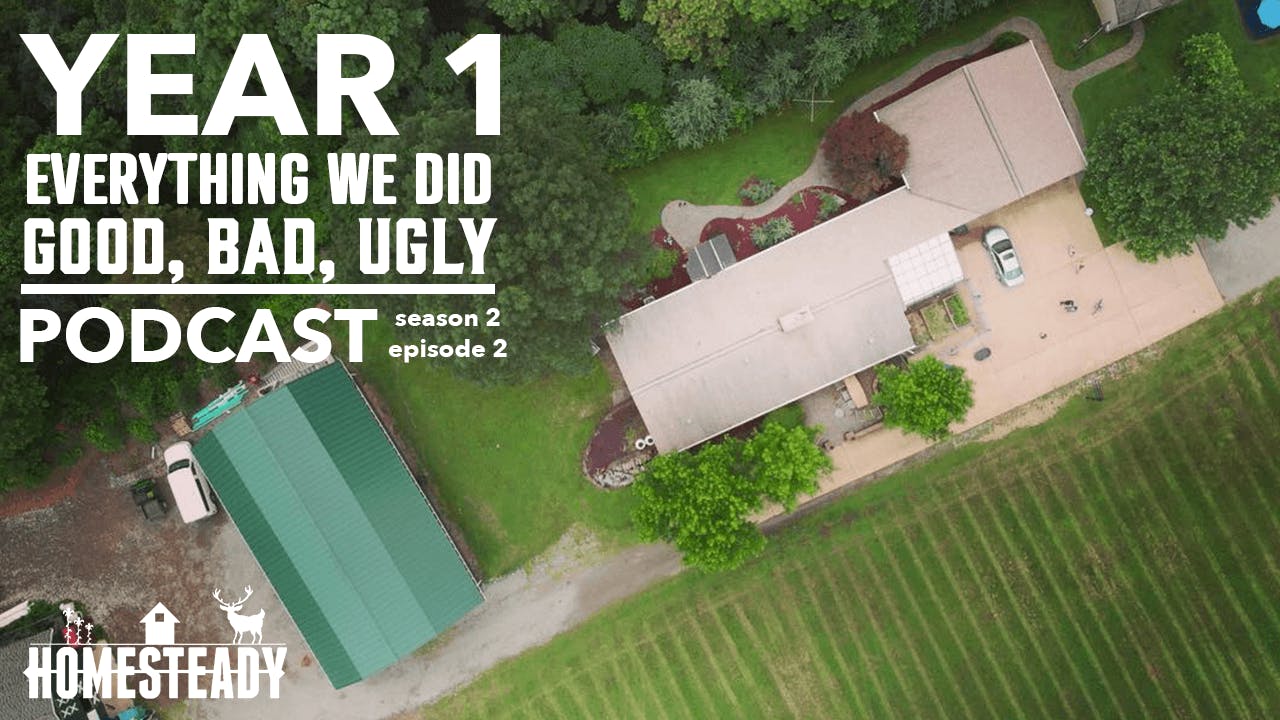
Homesteady - Stories of Living off the Land
Society & Culture:Personal Journals

THE GOOD, THE BAD, AND THE UGLY YEAR 1 AT OUR NEW HOMESTEAD
 2019-05-06
2019-05-06
We are settled into our new homestead. Finally. But it was a LOT of work getting to this point.
When our homestead in CT went onto the market to be sold things moved quickly. In just 10 days we had an offer on the place and accepted it.
Suddenly we needed a place to live in PA WAY FASTER than we expected. We needed to figure out what we were going to live in.
We have wanted to live in a Yurt for almost as long as we have been married.
The dream of the yurt resurfaced. We needed a inexpensive structure that could house us for at least a few months, that we could put up quickly.
The yurt seemed like a perfect idea. But a harder look at the yurt, and the expense, made us decide otherwise.
On the family farm there was already a Pole Barn build, with insulated walls and electricity run to it. The shell was done, and upstairs above the pole barn was 1000 square feet of unfinished space. It was a no brainer.
The yurt dream had to die… once again.
Maybe someday K and I will wind up as empty nesters, living our days within the round cozy walls of a yurt. But for now, that remains just a dream.
Work began on the pole barn. Turning an unfinished pole barn into a home takes a LOT of materials!
The upstairs space was wide open. The floors were plywood, and the walls and ceilings metal. There was big LED lights on the ceiling and electric already run, but the rest of what we needed to put into the house we needed to buy or scrounge.
We purchased lumber, sheetrock, flooring, paint, and all the hardware and supplies needed to build the interior. In addition to those supplies we needed to buy a toilett, 2 sinks, and bathtub. We put in a washer, dryer, and dishwasher. Also we added an electric hot water heater and 2 heat/AC units.
The kitchen cabinets were a steal for us, as we had a family member who was turning a home into a salon and was getting rid of an entire kitchen, cabinets, stove and fridge. That we got for FREE and it was a big savings to us! The only added expense to the kitchen was the counter tops that needed to be made to match the new layout.
We couldn’t DIY the entire project, we would need to hire some contractors.
We wanted to finish the space all ourself, but unfortunately we still had a farm in CT to run (until move out day) and so we could only dedicate 1 week to working on turning the pole barn upstairs into a living space.
We spent about $30,000 turning this unfinished space into a beautiful little living space for our large family.
When the dust settled, about 12,000 was spent on supplies and materials for the space, and between the carpenters, electricians, and plumbers we spent about 18,000 on labor.
All and all it was worth it.
Our family had a great space to live in for the last year while the second house on the family farm was being built, and now that we are out of the pole barn, we have a great guest space for visitors, and I have a awesome office to run my business out of.
Once the place we need to live in was built we could move onto the new homestead.
Since we had moved onto a homestead once before we had a good idea of what NOT to do and what we should spend our time doing on our new homestead.
3 Things You Don’t Want To Do On Your New Homestead
DON’T Invest a Whole Bunch Of Time and Money On Infrastructure. DON’T Get New Animals Right Away. DON’T Expect to Make Money Right Away.You are going to make mistakes the first year. Mistakes are a natural way we learn. The first time you burned your hand on something hot you learned not to touch hot things in the future.
If you avoid these 3 mistakes you will be ahead of us when we were new homesteaders, and you will get to learn your own lessons the hard way 😉
So what should you spend time doing on your new homestead?
Take walks daily on your new property.
Get to know it. Spend some time learning it. Whatever you see on those walks… capture it. Photos, journals, videos, whatever way you can capture what you are observing on your walks.
Setup temporary movable infrastructure.
If you have animals or are getting a few new ones, don’t setup permanent fences and waterlines yet… use moveable electric, hoses, and whatever other moveable infrastructure you can to learn your property before investing in permanent changes.
Fix what is broke.
If you don’t spend a bunch of time and money on new permanent infrastructure you will be saving it for the things that are going to break on you.
Our first year on our new PA homestead is done. We have settled in. What is in store for us? What farm plans do we have in our future? Find out in the next episode of the Homesteady Podcast.
More Episodes
 2015-05-01
2015-05-01
 14
14
 2015-02-12
2015-02-12
 10
10
Create your
podcast in
minutes
- Full-featured podcast site
- Unlimited storage and bandwidth
- Comprehensive podcast stats
- Distribute to Apple Podcasts, Spotify, and more
- Make money with your podcast
It is Free
- Privacy Policy
- Cookie Policy
- Terms of Use
- Consent Preferences
- Copyright © 2015-2024 Podbean.com


